The Development of Winegrowing in New York State
New York presents four different viticultural regions, running from east to west across the state, whose development is roughly parallel to the westward movement of population. The first is around New York City, especially on Long Island; next is the Hudson Valley; then the Finger Lakes of the central part of the state; and last the so-called Chautauqua region, an extension into western New York of the shorelands along Lake Erie.
The gardeners of Long Island, having a large concentrated market just beyond their doorsteps in the city, were naturally interested in seeing if they could succeed in growing wine for it. Not surprisingly, one of the first was a Frenchman, a merchant named Alphonse Loubat, who came originally from the south of France. At a date unrecorded but probably in the 1820s, he set out a vineyard of some forty acres—a notably ambitious effort—at New Utrecht, as it was then known; it is now a part of the Brooklyn waterfront, where the idea of any growing crop is impossible to conceive. Loubat's vines were vinifera, as a Frenchman's would be. Black rot and powdery mildew descended upon him, and he set himself to struggle against them. In the process he is said to have invented the practice of bagging the clusters against their depredations. But at last he was compelled to admit that they were too much for human effort to overcome.[115]
Loubat left a permanent memorial in the shape of a curious little book with the same title as Dufour's, The American Vine-Dresser's Guide , and published just a year later than Dufour's, in 1827, in New York. The book, in French and English on facing pages, opens with a delightful dedication "To the Shade of Franklin"—"À L'Ombre de Franklin." The great man's ghost is invoked to "Protect my feeble essay" and to "protect my vine, and cause it so to thrive that I shall soon be able to pour forth upon thy tomb libations of perfumed Muscatel and generous Malmsey."[116] At the time that he published his Guide , Loubat seems to have had no suspicion at all that his vinifera were doomed, or that the failure of winegrowing in the United States was owing to anything but the inexplicable neglect of a splendid opportunity. The instruction conveyed in his Guide is without any reference to American conditions, and assumes that French practices can be taken over unaltered. He soon had reason to think otherwise, and in 1835 the enterprise that he strove to establish along the banks of the East River came to a rude end when the vineyard property was sold for building lots.[117]
Still, before the end, his work had attracted some attention. Longworth's early trials in Ohio of vinifera were made with vines that he got from Loubat.[118] Another Long Islander, Alden Spooner, the editor of the Brooklyn Long Island City Star and one of the leading citizens of that pastoral community, had watched Loubat's struggles with sympathetic interest, and around 1827 began, in imitation, to plant vinifera grapes in his Brooklyn vineyard, now a part of Prospect Park.[119] Unlike Loubat, however, Spooner soon concluded that the native vines were the only safe bet. He planted the Isabella grape instead, and with this he had success enough to
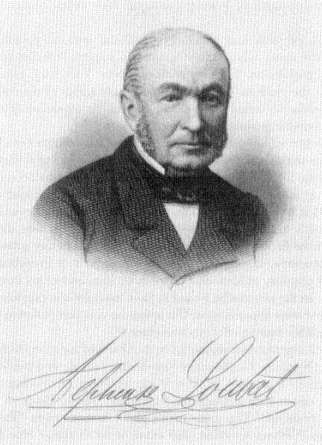
53
Alphonse Loubat, a New York merchant born in France, planted a large
vineyard of vinifera vines in Brooklyn in the 1820s and published a book,
in both French and English, called The American Vine-Dresser's Guide
(1827). Interesting chiefly as a late memorial to the futile belief that vinifera
would do well in the American East after two hundred years of unbroken
failure, it was, for some inexplicable reason, reprinted in 1872, when its views
had long been discredited. (From Loubat, The American Vine-Dresser's
Guide [New York, 1872])
lead him to publish a book (he commanded a press and a bookstore, as well as a newspaper). Spooner's The Cultivation of American Grape Fines and Making of Wine (1846) is a scissors-and-paste job, of the sort that journalists know so well how to do, but it preserves some authentic anecdotes and is useful evidence of the interest in grape growing around New York City at that time.
The most important by far of the early Long Island grape growers was William Robert Prince, the son, grandson, and great-grandson of nurserymen.[120] The Princes operated the elegantly named Linnaean Botanic Garden at Flushing, Long Island, where, among other horticultural specialities, they kept a large collec-
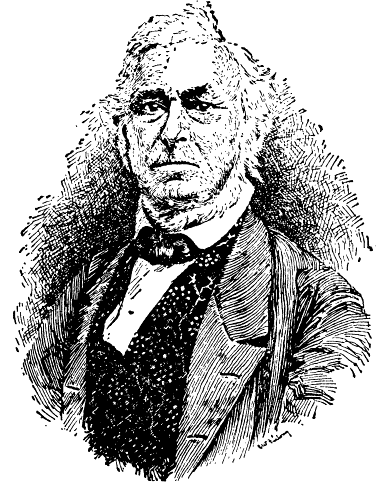
54
A member of the fourth generation of a family of Long Island nurserymen,
William Robert Prince (1795—1869) made a special study of the grape and
published the first comprehensive book on the subject in this country, A
Treatise on the Vine (1830). Prince introduced one of the most successful
of the early hybrids, the Isabella grape. (From U. P. Hedrick, Manual of
American Grape Growing [1924])
tion of grapes, both native and foreign, for sale: their catalogue for 1830 lists 513 varieties.[121] The youngest Prince, as his father had before him, took a special interest in viticulture and became one of the recognized experts on the subject in the first part of the century, writing frequently for the horticultural magazines and developing the section devoted to vines in his nursery catalogue into a substantial essay on the subject. In 1830 he published a separate work called A Treatise on the Vine , an ambitious and expansive discourse that undertakes, in the easy and inconsequent style of those prespecialized days, to provide a history of the vine from
Noah downwards, a description of two hundred and eighty varieties of grape, and instruction on the "establishment, culture, and management of vineyards." The work is dedicated to Henry Clay in recognition of his part in founding the Kentucky Vineyard Society many years before.
Compared to anything else on viticulture by American writers, the Treatise was a work of an entirely different and higher order—"the first good book on grapes," as Hedrick says.[122] Prince made a serious effort at straightening out the tangle of names used to identify native grapes, and, in his description of native varieties, organized a great deal of local historical information; his prominence as the proprietor of America's best-known nursery made it possible for him to obtain information that no one else could have. Prince promised to publish a second part of his Treatise , to include a "topographical account of all the known vineyards throughout the world, and including those of the United States";[123] for whatever reason, this never appeared, and we can only regret what would have been an unparalleled description of early nineteenth-century viticulture in the United States. He did, at least, print a list of his correspondents and sources, which includes some familiar names: Bolling, whose "Sketch" had been given to Prince; Thomas McCall of Georgia, "who has presented me with a detailed manuscript of his experiments and success in making wines"; and Herbemont, Eichelberger, and Spooner.[124]
Since Prince was able to grow vinifera vines successfully under nursery conditions, he was slow to give up faith in them. A large part of his book is devoted to foreign grapes, which he was confident would grow well in this country. He particularly recommended the Alicante. And no matter what the variety of vinifera, its failure, he thought, could in every case be explained by bad management.[125] An equally large part of Prince's Treatise is devoted to descriptions of some eighty native varieties, far and away the most comprehensive account of the subject that had yet appeared. His own experience showed him the need for improved American varieties, and he was himself one of the earliest of the country's hybridizers, though he does not seem to have introduced any grape of his own breeding. The variety with which Prince's name is associated is the Isabella, which his father obtained in 1816 from Colonel George Gibbs of Long Island, an amateur grower, and named after Gibbs's wife. The grape itself is of disputed origin, but it is generally supposed to be from South Carolina.[126] The Princes did not promote the Isabella at once, but, after Adlum's success in creating notoriety for the Catawba, they began to put forward the Isabella as a superior rival.[127] Unlike Adlum, William Robert Prince was under no illusion as to the value of his labrusca seedling compared to the standard vinifera; still, he wrote of the Isabella, "I have made wine from it of excellent quality, and which has met with the approbation of some of the most accurate judges in our country."[128]
Prince has little to say about mildew and black rot, the diseases that were the bane of native hybrids throughout the East; there is plenty of evidence that these afflictions plagued grape growers around New York when Prince was writing, but he gives them no particular emphasis in his discussion of grape culture. One no-
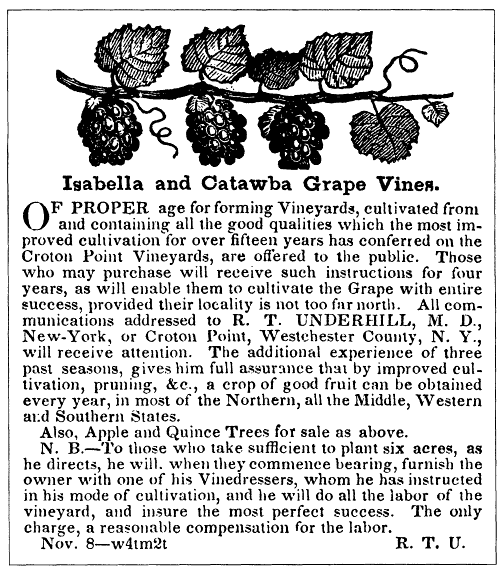
55
An advertisement for vines from the Croton Point Vineyards of Dr. Robert Underhill (1802-71).
Note the offer to send a vine dresser to take care of the vines "when they commence bearing."
After a generation of successful grape growing along the Hudson, Underhill was himself just
beginning to make wine for the New York City market. ( The Cultivator , December 1855)
table thing he does do, however, is to call attention to the efficacy of spraying with a mixture of lime and sulfur against mildew. He was the first to do so in this country.[129]
Long Island may be imagined in the early part of the nineteenth century as a rural spot where grape growing for ornament and home use was widespread—local patriotism favored the Isabella, which "soon became the cherished ornament and pride of every garden and door-yard."[130] There, Colonel Gibbs, from whose garden the Isabella came, amused himself with a vineyard, as did Colonel Spooner; there, poor Loubat struggled and failed to compel vinifera to grow on a commercial scale; and there the learned Prince poured out, through his catalogues and monographs, information to the country at large from his base in the Linnaean Botanic Garden. Grapes did grow in Brooklyn (and there are wineries there today; that is a different story). One should also mention the famous nursery and botanic garden founded on twenty sterile, rocky acres at the junction of Jamaica and Flat-bush Avenues in 1825 by the Belgian emigré André Parmentier. This quickly became a flourishing garden, complete with rustic observation tower. Parmentier collected and distributed an unprecedentedly comprehensive variety of imported and native plants, including grapes.[131] All of his grapes were, unluckily, imported, and so his work in that line was more enterprising than fruitful. Also unfulfilled was Parmentier's intention to publish an "Essay on the Cultivation of the Vine," left unfinished at his untimely death in 1830.[132] Long Island thus presented the spectacle of much hopeful activity, but did not get beyond the promise of interesting beginnings.
North from Manhattan, along the Hudson, a landowner named Robert Under-hill, using vinifera vines from Parmentier, laid out a vineyard at Croton Point sometime before 1827—probably just a year or so earlier. By 1827 the failure of the vines was clear to him, and he replaced them with Catawba and Isabella.[133] These grew, and their fresh fruit found a ready and profitable market in New York City. Underhill died in 1829, but his two sons, Robert, a doctor who gave up his practice for vine growing, and William, continued the vineyard at Croton Point in separate holdings; by 1843 the Underhills had twenty-seven acres of vineyard; ultimately, they had seventy-five acres in vines.[134] The scale and the long life of their vineyards give them a claim to be the real founders of the winegrowing industry in New York. But they were not, at first, winegrowers, merely grape growers. Then Robert Underhill, while continuing to sell grapes, began to make wine for himself, and, at last, in 1859, he began to send Isabella and catawba wine to the New York market.[135] Croton Point wines, sold from the "Pure Wine and Grape Depot" in New York City, were advertised as "the pure product of the grape, neither drugged, liquored, nor watered, recommended by leading physicians in all cases where a stimulant of bracing character is required."[136] One notes the emphasis upon therapeutic value, forgivable perhaps in the case of wine produced by a physician, but almost always a sign of the puritanical suspicion of simple sensuous gratification. Dr. Underhill, it may be mentioned, was the first sponsor in the
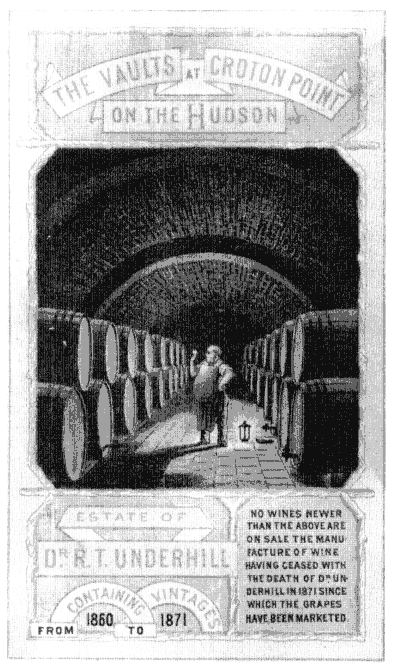
56
Dr. Robert Underhill died in 1871, a little more than a decade after he began making wine
at his Croton Point Vineyards. This advertisement offers the wines left after his death,
all manufactured in the years 1860-71. (Huntington Library)
United States of the so-called grape cure, one of the many regimens designed to clean out the overfed systems of prosperous Victorians, and then fashionable in Europe. Since the cure consisted in eating five or six pounds of grapes daily, Underhill obviously had an interested motive in sponsoring it.[137]
The Underhills made another contribution to New York viticulture in the form of William's son Stephen, who, between 1860 and 1870, introduced a number of hybrid varieties of his creation and sold them through his nursery. The three generations of Underhills working at Croton Point are a first dynasty in American viticulture (their property is now a county park).[138]
A few miles north of Croton Point, a Frenchman named Thomas Gimbrede was experimenting with native vines at West Point, where he taught drawing to the cadets. Starting about 1820, Gimbrede had collected every variety that he found growing wild in the woods and transplanted them to his garden, "manuring, stimulating and pruning them with great care, in the hope of changing and ameliorating their character." After fifteen years of such experiment, Gimbrede was candid enough to admit that he had had no luck whatever: the natives remained obstinately unimproved by their pampering.[139] But perhaps this barren result may have helped put an end to the notion, so long and fondly entertained, that the "wild" grape could be "tamed" by so simple a process of cultivation in which, as one writer has said, the experimenter acts as a sociologist instead of a geneticist.[140] One hears little of the "taming" idea afterwards.
The first successful commercial winery in New York was founded by a Frenchman named Jean Jaques in 1839, at Washingtonville, on the west bank of the Hudson. Under the name of Blooming Grove, the winery business did well enough to be continued by his sons. In the 1870s the surviving son sold the winery to a firm of New York wine merchants who also dealt in the wines from the original Brotherhood Winery in Brocton, New York. The name of the Washingtonville winery was then changed to Brotherhood, for though the Brocton firm no longer existed, its name continued to have market value. Grapes are no longer grown on the Washingtonville property, and the firm has passed through many transformations, but it survived Prohibition by making sacramental wine and is still going. The winery may fairly claim to be the oldest such enterprise in continuous operation in this country and helps to bolster New York's claim to a central place in the commercial history of wine in America.[141]
One hundred and fifty miles west of the Hudson Valley lie the long, narrow, deep strips of water whose arrangement on the map like the outstretched fingers of a hand has given them their name of Finger Lakes. As Philip Wagner has written, "their beauty is famous and their geology fascinating."[142] But for Wagner and for us, their main interest is in their status as a winegrowing region. The lakes, with their adjacent highlands, keep the climate of the valleys much more equable than in the nearby regions, producing warmer winters and cooler summers and so favoring the grape.[143]
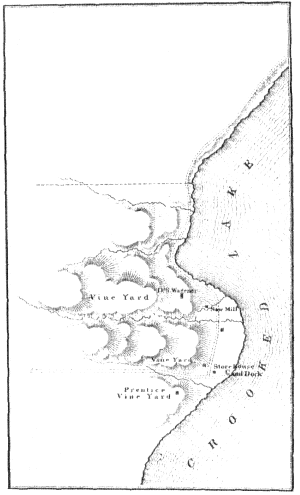
57
The first vineyards in the Finger Lakes region were planted on this
spot along the west bank of Keuka Lake (then called Crooked
Lake) beginning in 1836. (From Goldsmith Denniston, Grape Culture
in Steuben County [1865])
The Finger Lakes district is, and has long been, the main source of fine table wine, including sparkling wine, in the eastern United States. Its rise to this eminence was not particularly early or rapid, however; the history of the region's development largely belongs to the period after the Civil War, as is also the case in Ohio and Missouri. But, as in those states too, the beginnings at least were clearly made before the war. According to the received account, the first cultivated grapes in the Finger Lakes district were set out about 1830 (the date is disputed) by the Reverend William Bostwick, rector of the newly founded Episcopal Church in
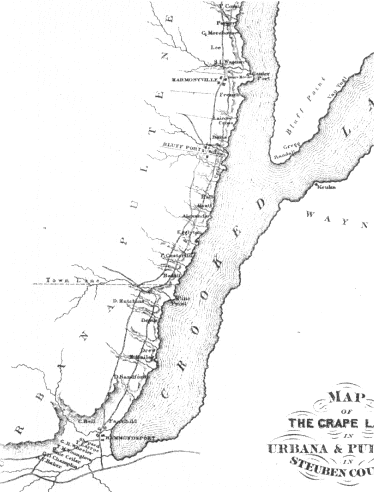
58
The viticultural region of Keuka Lake (Crooked Lake) as it developed after 1836.
The Pleasant Valley subregion lies at the far lower left corner of the map, behind
the town of Hammondsport. It was here that the large-scale winemaking enterprises
of the valley developed. (From Goldsmith Denniston, Grape Culture in Steuben County [1865])
Hammondsport, at the south end of Keuka Lake (or Crooked Lake, as it was then called).[144] There is no record that Bostwick ever made wine from his grapes—he had only a few vines of Catawba and Isabella--but it is pleasant to have his example to show that the ancient tradition linking wine and the church included, in this country, not only the Catholic, the Huguenot, and the German Protestant, but the Anglican communion as well.
Bostwick's example was followed by his neighbors, perhaps with the greatest enthusiasm by J. W. Prentiss, who beginning in 1836 developed a three-acre vine-
yard on the shores of Keuka in the township of Pulteney with vines from Bostwick's garden.[145] Another significant event in the district was the arrival, after 1848, of experienced German vineyardists, refugees from the political revolutions of the Continent. One of these, Andrew Reisenger, after observing Prentiss's success with his small vineyard, set out two or three acres of his own in the same region of the western lake shore, at Harmony, in 1853.[146] The excellent results of Reisenger's professional practices—unknown until then in the neighborhood—showed what crops and profits might be made from viticulture. Local men of substance soon followed Reisenger's lead: planting began in 1855 on the land south of Hammondsport, a shallow valley once a part of the lake and now called Pleasant Valley.[147] The presence of the new German immigrants gave the region an advantage by providing a ready source of experienced labor. By 1859, Hedrick estimates, there were four or five hundred acres of grapes around Keuka Lake.[148] Planting had extended not only south to Pleasant Valley but north into Yates County and to the eastern shore of the lake around Wayne. It included all the established native varieties: Catawba, Isabella, Delaware, Diana, Iona for white wine; Concord, Norton, Ives, and Clinton for red. The market—at first mostly for fresh fruit—was so good that local enthusiasts proclaimed that "a bearing vineyard was as good as a gold mine."[149]
To take advantage of this considerable source, the first winery at Hammondsport, which has been from that time the center of the Finger Lakes industry, was founded in 1860 as the Hammondsport and Pleasant Valley Wine Company, incorporated for the purpose of producing wine, brandy, and champagne.[150] The head of this enterprise was Charles Champlin, one of the gentlemen growing grapes in Pleasant Valley, who was joined in the founding of the company by other Pleasant Valley growers. The handsome stone building that Champlin and his associates put up on the slope looking over Pleasant Valley still stands there. The first winemaker was a German named Weber,[151] but the winery aimed at a French style. The plan to produce a sparkling wine meant that a champagne maker would have to be imported: Longworth had already established that pattern in Cincinnati, and so had the Sainsevains in California. To make the French claim even plainer, the winery obtained the post office address of Rheims, and long continued to use it. The first champagne master was Joseph Masson, who was followed by a brother, Jules, and Jules by his son, Victor.[152] Both of the Masson brothers, originally from France, had come to this country to make sparkling wine in Cincinnati.[153] Thus did the production of sparkling wine in the East, after the decline of the vineyards along the Ohio, reappear and prosper under a succession of Frenchmen. But if the winemaking was French, one must remember that the vine growing owed much to the Germans.
The Pleasant Valley Wine Company shipped its first wine in 1862, and by 1864 its production had risen to around 30,000 gallons.[154] In 1867, at a banquet in Boston, its fame was made. That was a time when the literati of Boston were the tastemakers of the country, and they not merely approved of Champlin's sparkling
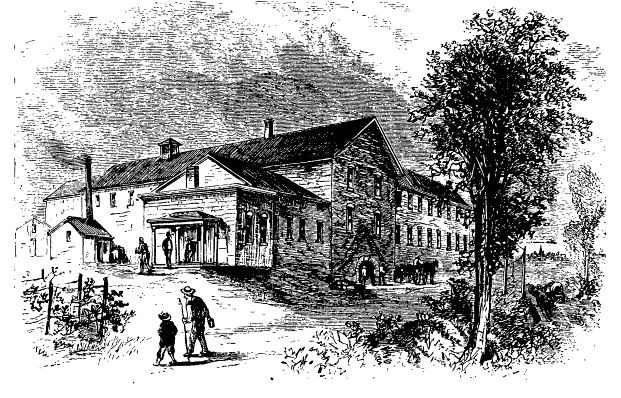
59
The first winery erected in the Finger Lakes Region, the Pleasant Valley winery
building still stands and is still an operating winery. ( Harper's Weekly , 11 May 1872)
wine, they gave it a name. From the point of view of Boston—the Hub, as they would have said—Pleasant Valley wine came from the remote reaches of the great West: it should be known, therefore, as "Great Western" sparkling wine, and so it has been since.[155] The name of the firm remains Pleasant Valley, but the name on its labels is always "Great Western."
Over the ridge to the west and north of Hammondsport the next valley is that of Canandaigua Lake, where grape growing on a commercial scale was begun in 1854 by a lawyer named Edward McKay, who planted Isabella vines on an acre of ground.[156] In a few years he had an excellent crop, and so his friends and neighbors began to plant vines too. The first winery was put up in 1861 at Naples, on Canandaigua Lake, by the town banker, Hiram Maxfield.[157] After the war a considerable migration of Germans and Swiss to the region took place, and the continued development of winegrowing in the Naples Valley was largely their work. Other sites along the Finger Lakes were being developed as vineyards in the 1850s and 1860s:
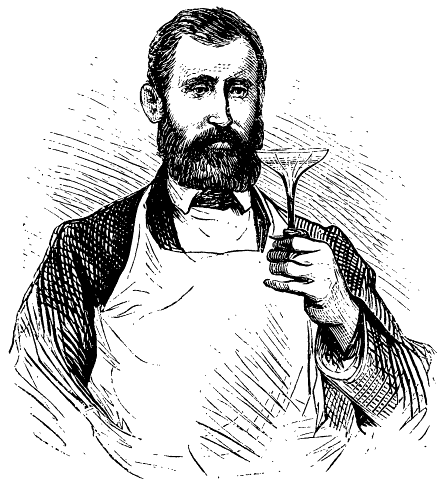
60
Jules Masson, who succeeded his brother Joseph as champagne master at the Pleasant
Valley Wine Company in the 1860s. They founded the manufacture of sparkling wine in
New York State. (Harper's Weekly , 11 May 1872)
Union Springs, on Cayuga Lake, was one center;[158] the hillsides of Seneca, largest of the Finger Lakes, began to be planted in 1862.[159] Winemaking, however, stayed close to Keuka and Canandaigua lakes, where it has mostly remained ever since.
Central New York, since the time of its first prosperity through the Erie Canal, has had an honorable place in the history of American horticulture. Generations of orchardists, vineyardists, nurserymen, and, latterly, plant scientists, have introduced and experimented with a great variety of fruits, and have especially attended to the grape. The great monument to this activity in the nineteenth century is the magisterial tome—it can hardly be called a mere book—entitled The Grapes of New
York , produced by the New York Agricultural Experiment Station at Geneva (also in the Finger Lakes region) in 1908. This work, of some 564 large quarto pages, lavishly illustrated with color plates, was published at the expense of the state under the supervision of the plant scientist U. P. Hedrick, and covers a far wider range than the title indicates. It is in fact an encyclopedia of the history of grape growing in the eastern United States to the time of its publication; it makes clear how large and important a part the work of growers, hybridizers, and scientists in upstate New York has had in that history. No doubt mere historical accident had something to do with all this: while others sought out chance seedlings, as Adlum did in Maryland, or undertook the expensive and frustrating labor of developing sound winemaking practices in unfamiliar conditions, as Longworth did in Cincinnati, the horticulturists of New York were not at all in the forefront of winemaking. When their moment came, however, they were ready, and since the early years of experiment along the Hudson, the state of New York has counted in eastern viticulture and winemaking as no other state has. This need not be a permanent condition of things, but the fact deserves to be recognized here.
The fourth and westernmost region of New York viticulture is along the shores of Lake Erie. The lake shore, which stretches over Ohio, Pennsylvania, and New York, provides the largest developed grape growing belt in the United States outside California. Planting began around Cleveland in the 1830s and around Sandusky in the next decade, though commercial development did not go very far before the 1860s. The pattern was pretty much the same in the New York section of the shoreline, which lies mostly in Chautauqua County, famous for the Chautauqua Institution as well as for its grapes—an ironic combination, given the prohibitionist character of the Chautauqua movement (the Woman's Christian Temperance Union was conceived at Chautauqua Lake in 1874).
The "grape belt" of western New York, as it has been called since the nineteenth century, occupies a narrow terrace between the waters of the lake and the high ground called the Allegheny Escarpment; the belt extends on one side to Erie, Pennsylvania, and on the other into Erie County, New York, south of Buffalo. The soil is thin, gravelly, and well drained, and though not sufficiently fertile for general farming it is well suited for grapes. More important than soil is climate: excellent air drainage retards fungus diseases, and helps to prevent frost. The combined effect of the lake and of the escarpment makes the growing season notably longer', the winters milder, the summers warmer than in the surrounding hills and valleys. The annual rainfall is less than that of the neighboring lands, to the advantage of the grape. Tradition says that the first grapevines planted in far western New York were cuttings from Massachusetts set out in 1818 on his farm in Brocton by Elijah Fay, a transplanted Yankee among the early settlers of the region. When these vines failed to do well, Fay obtained some plants of Catawba and Isabella from the Long Island nursery of William Prince and planted those in 1824.[160] From that beginning the Chautauqua region began its slow development into what became., later in the century, a virtual monoculture economy of the grape.
Elijah Fay began making wine for himself in 1830 and continued to do so until
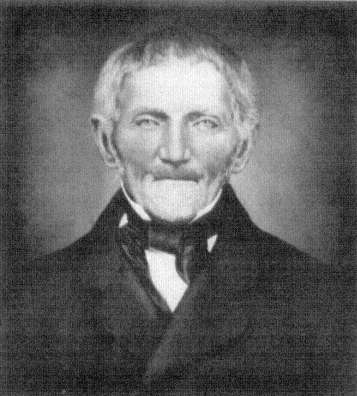
61
Deacon Elijah Fay (1781-1860). A Massachusetts Yankee who migrated
to the shores of Lake Erie in 1811, Fay is credited with planting the first
grapes in the Grape Belt of New York State. He began winemaking in 1830,
in part to supply sacramental wine to the First Baptist Church of Brocton,
of which he was an early deacon. (From John B. Downs, History of Chautauqua
County [1921])
his death in 1860. He was a deacon of the Baptist Church at Brocton, and so maintains the tradition of church and vine. His example does not seem to have inspired many imitators, but here and there small plantings were made, and Fay's family carried on the work. Joseph Fay, son of Elijah, planted the first commercial vineyard of the region in 1851[161] Lincoln Fay, a nephew, was responsible for introducing the Concord grape in the late 1850s.[162] That was a decisive step, for in the Chautauqua grape belt the Concord quickly succeeded in driving out the Catawba and the Isabella, and has ever since remained the overwhelmingly dominant grape. This fact has served to distinguish the eastern, or New York, end of the Lake Erie shore from its western, or Ohio, end, where the Catawba held out against the Concord. In consequence, the Ohio end has always maintained its identity as a wine-growing region, while the New York end has for many years been the great national source of grape juice. That, however, was a late nineteenth-century turn of affairs.
The sudden expansion of the industry in Chautauqua County dates from the
end of the 1850s, as it does also in the Finger Lakes and along the Ohio shore of Lake Erie. In 1859, when there were but a scant forty acres of vines in the county, the first winery, the Brocton Wine Cellars, was founded by three men, one of whom was a son and another the grandson of Elijah Fay, the original vineyardist of the region. The winery produced a modest 2,000 gallons in its first season, from which beginning it grew into a large and profitable business. In 1865 the winery had an inventory of 37,000 gallons, and the forty acres of vines around Brocton had jumped to four hundred: the rapid establishment of a "grape belt" was under way.[163] Western New York thus joined the pattern that was clearly developing in the northern states just before and during the Civil War, a pattern in which the long, intermittent, and frustrating preparations for a winemaking industry were at last completed and the basis laid for the production of wine in significant quantities from native grapes. Despite the years lost to the Civil War in the first half of the decade, the 1860s were the years of a "grape boom," years in which the acreage of vines in New York, Ohio, and Missouri increased at geometrical rates, when wineries were opened to take advantage of the new production, when new varieties were introduced almost daily to an eager public caught up in what the papers called the "grape mania." Some other elements that helped to generate the mania are taken up in the next chapter.